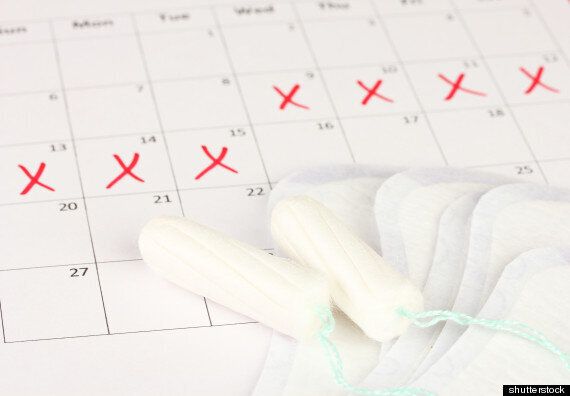
The reproductive cycle is a complex little factory that operates underneath layers of skin, muscles and organs for roughly 28 days. Now while this silent operation may feel like nothing (unless of course you experience cramps during your period), most of time, women just don't know what's happening day-by-day.
And though you may have heard the phrase "28 day cycle" your whole life, if your period has a different timeline, don't be alarmed.
"A 'normal' cycle can range anywhere from 21 to 36 days, so this is approximate," says Lauren Streicher, associate clinical professor of Obstetrics and Gynecology at Northwestern University’s Medical School. She notes any "regular" cycle you see described (like the one below) is based on a woman who is not taking the birth control pill. "Otherwise it’s the pill talking, not your ovaries."
The two major hormones associated with the reproductive cycle are estrogen and progesterone (a type of steroid hormone that is responsible for preparing the uterus for pregnancy). While these two hormones are important for your cycle, other hormones also help your cycle function as a whole, according to The Doctors.
Although every woman's reproductive cycle is different, the chart below outlines generally what a 28-day cycle looks like. Streicher goes through how menstruation changes in a month, as well as tips for women who are trying to conceive.

The first day of your period also happens to be the first day of your cycle. Unless you’re pregnant, your hormone levels plummet, and the blood and tissues lining your uterus break down and begin to shed. "The next 28 days are all about your ever-optimistic uterus prepping for the possibility of a nine-month house guest," says Lauren Streicher, associate clinical professor of Obstetrics and Gynecology at Northwestern University’s Medical School.
Your period is in full swing. Streicher says the second day of your cycle is generally a heavier one. Today is the day you want to use a super tampon or heavy-flow pad — and make sure you change them regularly. If you happen to find a small clot of blood on your pad or underwear, don't panic. "That’s perfectly normal for this point in your cycle. But if you’re going through a box of tampons in a day and passing plum-sized clots, get checked out by a doctor."
Generally, for most women, this is the final day of heavy bleeding. In the next few days, you will probably still see red blood and/or deal with stomach aches. "You may also experience some changes in your vaginal pH around now, which could lead to yeast infections and bad odours. If so, try an over-the-counter vaginal probiotic." Streicher recommends Pro-B to balance things out.
Good news! Your period is getting lighter and some of you may notice it go from bright red to brown.
If your period ends around day five, use a panty liner for any additional spotting.
For many, this is the first day you’ll be free from your period. Other women have periods that can last up to seven days, which again, is perfectly normal.

By now, your period should be almost gone (or gone completely for some). This means that your body is gearing up for next month and the next phase. "Small follicles (little cysts on the ovaries that will release an egg or two) are starting to form. Estrogen levels are starting to rise, testosterone is still low, and progesterone is still absent," Streicher says.
Those follicles are growing and preparing to release an egg, and as the eggs start to develop, they produce estrogen. Testosterone and progesterone levels. however, will stay the same.
"Over the next few days, one follicle will continue to develop toward reaching maturity. That extra estrogen causes the lining of the uterus, rich with blood and nutrients, to thicken, so it’s ready if a fertilized egg implants."
At this point, estrogen production should now be off the charts, and your endometrium (the lining of the womb), continues to prepare for a potential pregnancy.
"If you’re trying to conceive, now’s the time to kick your efforts into high gear since you’re either ovulating or getting close to ovulation," Streicher says. When it comes to sex and you're not in the mood, try using lubricant to make planned sex more enjoyable. Try using a fertility friendly one for better sperm motility. Streiche suggests Pre-Seed, but talk to your doctor about other options.
Even though you may not be ovulating yet, your fertility levels are high due to increased estrogen production. "Your cervical mucous is flowing and stretchy, and the main follicle should be fully ready to release an egg while the others shrivel up," she says. By day 12, you may also notice increased libido — so if you want to have a baby, it's time to get busy.
Estrogen levels are peaking, and your body is almost ready for an egg to emerge from the ovarian follicle. This, my friends, is ovulation.

You’re ovulating, hooray! "You may feel a twinge of pain or have a little spotting, which is perfectly normal. This is your best baby-making day, so if you’re trying, whip out the lube and get to it. If you’re not, don’t skip that condom," Streicher says.
Your egg is starting its journey down the tube in hopes of meeting a sperm. If you are trying to get pregnant, intercourse on the day after ovulation is good practice. Streicher says If things start to get funky down there (a common occurrence with frequent intercourse), she recommends RepHresh gel to keep your vaginal pH in check.
The ever hopeful egg is still hanging out in the tube waiting for Mr. Sperm.

The lining of the uterus is getting thick again. "If the egg has successfully united with sperm, it will soon make its home there. If conception hasn’t taken place within 24 hours of ovulation, the egg will die." Estrogen levels are on their way down, while progesterone levels are sky high.
Now estrogen will start to make its comeback. Progesterone levels are still up there.
If you’re trying to get pregnant, or concerned that you might accidentally be pregnant, don’t head to the drugstore just yet — it still may be too soon to take a pregnancy test.
The end of your cycle is near, and it’s around this time that PMS symptoms will start. You may feel slightly bloated and moody.
By day 21, women who want to see if they are pregnant should go talk to their doctor or take a test.
Hey, your period is on its way! Make sure you have a stash of tampons ready to go.

At this point, Streicher says your PMS is in full swing. Treat yourself to a bubble bath or a chocolate bar, or whatever makes you feel good.
About a week after ovulation, your progesterone levels will be at a high. Estrogen will start to drift down.
This will probably be your worst PMS day — make sure you're equipped for major bloating.
"Don’t, I repeat, don’t get on the scale. It’s not you; it’s that pre-menstrual fluid retention," says Streicher.
Get excited: PMS symptoms are winding down and your period is almost here.
This is when your cycle comes to an end. "The uterine lining is at its thickest to get ready to shed. If you start taking ibuprofen today (the day before you bleed), it actually works better to reduce pain and decrease your flow." Tomorrow, we head back to day one.
